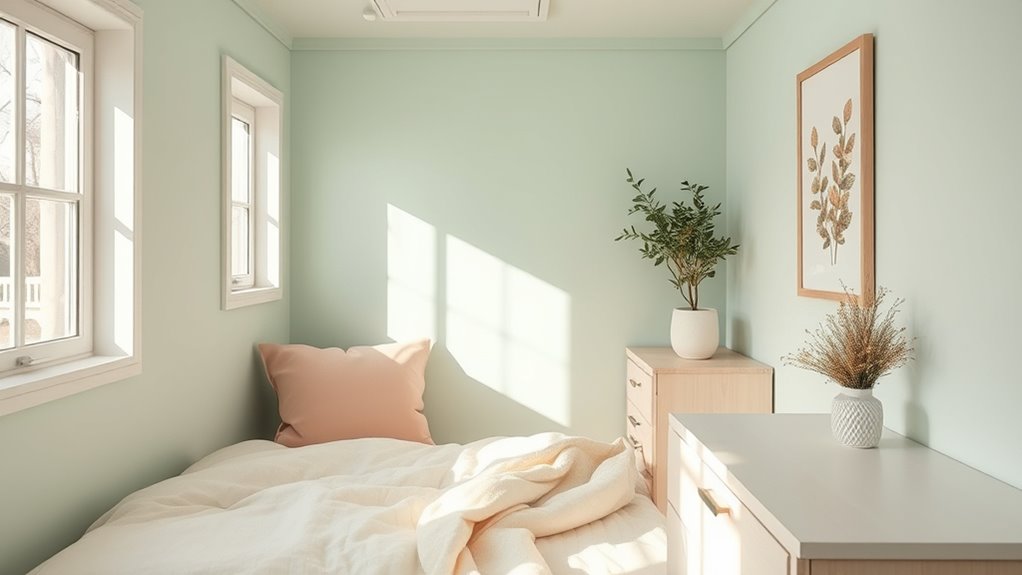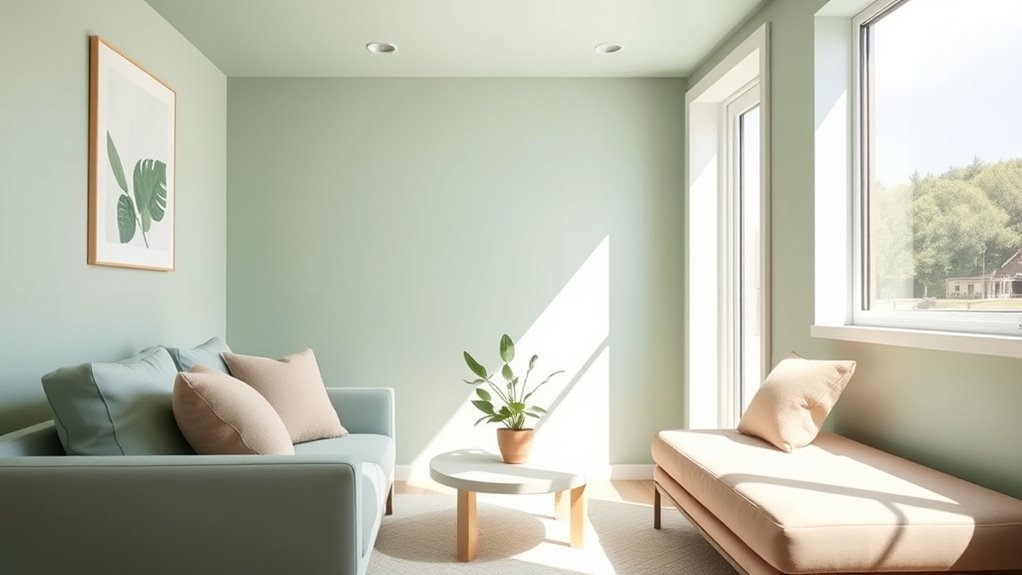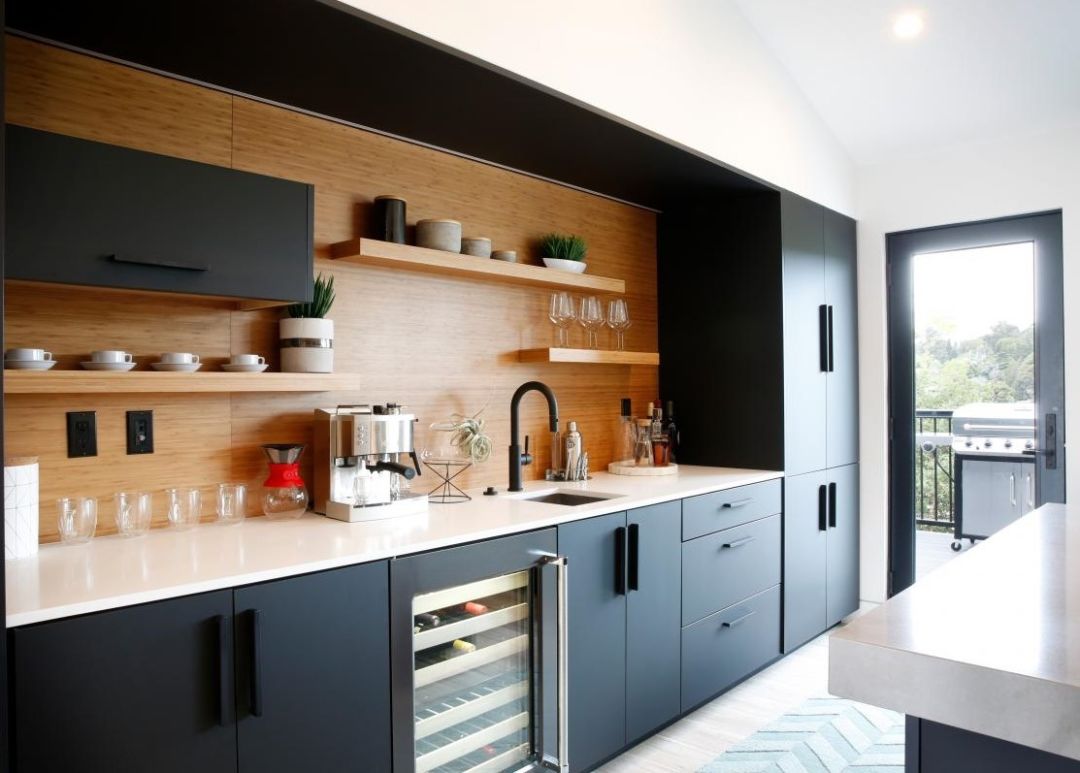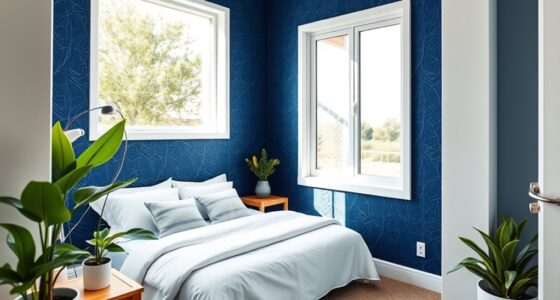Choosing the right paint colors in your tiny home directly impacts how spacious and inviting it feels, as well as your mood. Light shades like whites and pastels reflect more light, making your space seem larger and calmer, while bold or dark tones add depth and personality without overwhelming. Colors also influence your emotions—vibrant hues energize, while cooler tones promote relaxation. Understanding color psychology helps you create a supportive, uplifting environment tailored to your vibe; learn more to transform your space effectively.
Key Takeaways
- Light colors in tiny homes create an airy, spacious feel by reflecting more light and preventing the space from feeling closed in.
- Bold or dark hues add depth and personality, but should be balanced with lighter furnishings to maintain visual openness.
- Bright colors like yellow energize small areas, while cool shades such as blue promote calmness and reduce stress.
- Natural light influences how colors appear; brighter sunlight enhances warm tones, impacting mood and perception.
- Proper color choices can transform a tiny home into a supportive, uplifting sanctuary that reflects personality and promotes well-being.

Colors have a powerful impact on our emotions and behavior, often influencing how we feel in a space without us even realizing it. When decorating a tiny home, this effect becomes even more significant because every square inch counts. The right paint choices can make your space feel larger, cozier, calmer, or more energetic, depending on your mood and needs. Understanding the color influence allows you to harness paint to enhance your well-being and create a home that truly supports your lifestyle.
Colors influence mood and space perception—choose wisely to make your tiny home feel larger, cozy, or energizing.
In small spaces, light colors tend to reflect more light, making rooms feel more expansive. Soft whites, pastels, or muted neutrals can open up a room and foster a sense of airiness. These hues promote a mood of calm and relaxation, ideal for creating a peaceful retreat in a tiny home. On the other hand, bold or darker colors can add depth and personality, but they must be used thoughtfully to avoid overwhelming the space. For example, a deep navy accent wall can add sophistication without shrinking the room, especially if balanced with lighter furnishings. The key is to balance color influence with your desired mood; lighter shades tend to enhance serenity, while darker tones can evoke intimacy or drama.
Color influence also extends to mood enhancement. Bright, vibrant colors like yellow or coral can energize a small space, making it feel lively and inviting. These hues are perfect for areas where you want to boost activity or creativity, such as a kitchen or workspace corner. Conversely, cool shades like blue or green are known for their calming effects, helping to reduce stress and promote relaxation. Incorporating these colors into your tiny home can create a tranquil environment, helping you unwind after a busy day. Even subtle accents or accessories in these hues can influence the overall atmosphere without overwhelming the senses.
When selecting paint colors, consider the natural light your tiny home receives. Bright sunlight can make warm colors more lively, while dimmer lighting might require lighter shades to prevent the space from feeling closed in. Additionally, think about how different colors make you feel personally; your emotional response is essential in choosing a palette that supports your mood. Using color influence to enhance mood isn’t just about aesthetics—it’s about creating a home that nurtures your mental and emotional well-being. With intentional choices, your tiny home can become a sanctuary that reflects your personality and uplifts your spirit every time you step inside. Understanding color psychology can help you select hues that optimize your environment for happiness and comfort.
Frequently Asked Questions
How Can Color Influence Mood in Small Spaces?
Color influences your mood in small spaces by shaping your visual perception and creating harmony. Bright, warm hues like yellows and oranges can energize you, while cool colors like blues and greens promote calmness. Using a balanced color scheme enhances color harmony, making the room feel more spacious and inviting. This positive atmosphere directly impacts how you feel, helping you stay relaxed or motivated depending on your chosen palette.
Which Colors Make Tiny Rooms Appear Larger?
Choosing cool, crisp colors like whites, light grays, and soft beiges can make tiny rooms appear larger. You’ll want to maximize natural lighting and create clever color contrast to enhance openness. Light hues reflect more light, bouncing it around the space, while contrasting shades add depth without shrinking the room. Bright, airy colors combined with ample natural lighting create an inviting illusion of spaciousness, making your tiny home feel more expansive and elegant.
Are Certain Paint Finishes Better for Tiny Homes?
You should choose satin or eggshell finishes for tiny homes, as they offer a good balance of paint texture preferences and durability considerations. These finishes reflect light well, making your space feel larger, while resisting scuffs and stains. Avoid flat or matte paints, which can be harder to clean. Selecting the right finish guarantees your tiny home stays fresh, bright, and easy to maintain over time.
How Do Color Choices Affect Energy Efficiency?
Bright, reflective colors like whites and light neutrals bounce light, enhancing lighting effects and making your tiny space feel bigger and warmer, which can reduce the need for artificial lighting. Cooler color temperatures absorb more light, potentially increasing energy use, while warmer tones reflect it. Your color choices directly influence energy efficiency by affecting how much lighting you need, creating a cozy yet eco-friendly environment.
Can Color Psychology Vary by Culture in Tiny Homes?
Yes, cultural color meanings can influence your tiny home’s interior. You might find that regional paint preferences reflect local traditions and beliefs, shaping how colors are perceived. For example, red may symbolize luck in some cultures, while calming blue is preferred elsewhere. Understanding these cultural differences helps you choose paint colors that resonate personally and culturally, creating a space that feels both meaningful and harmonious in your tiny home.
Conclusion
Ultimately, choosing the right paint color can truly transform your tiny home, making it feel more spacious, cozy, or energizing. While some color theories are backed by research, trust your instincts and preferences too. Experiment with shades that make you feel happy and comfortable—after all, your home should reflect your personality. So, go ahead, pick those colors confidently, and enjoy creating a space that feels just right for you.









